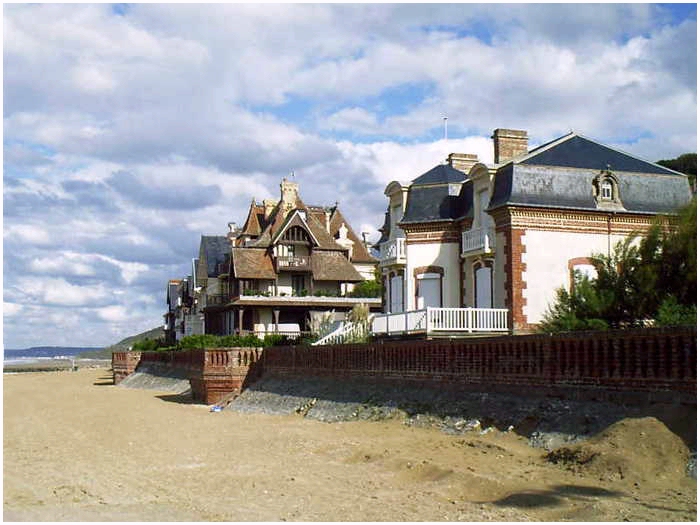|
DEFENCEWORKS BETWEEN
THE ORNE AND THE SEINE

Preface
A logical target for the Allies, if they chose Normandy for
the D-Day landings, would be the harbour of Le Havre, in the
bay of the Seine. Not only the Allies had their thoughts about
this spot. The Germans also realised the weakness in this place. So they
placed heavy guns at the mouth of the river Seine that
were able to give cross-fire. Around Le Havre were some heavy
guns. On the other side of the bay, between the Seine and the
Orne, they built also some impressive sites to cover the bay.
The Allies knew of this heavy defended place and decided not
to make any landings in this area out of sea. But the guns in
place were nevertheless of some danger during the assault on
D-Day. The guns had such a big range of fire, that the guns
had to be eliminated before the invasion took place on June,
6th, 1944.
A tour around some
objects
Our tour runs from Franceville-Plage to Honfleur.
We follow the coastal route D 513 and the D 514.
On the D514, and a kilometer before reaching Franceville-Plage, you drive through a long bent to the right.
At the end of this bent in the road, there is a
‘dance-hall’ established in a former German H634 MG bunker.
The bunker is painted white and is called appropriate 'The
Bunker' (once it was called 'Le Surfer' and after 1997 'La Noche').

The H634
rebuilt to house a party-center
The H634 had a cast iron turret with six loop-holes from
which two MG 34 could give fire. The turret was removed after
the war.

An example of such an iron turret can be found on a bunker near Colleville-Montgomey,
on the complex 'Hillman' (see picture above).
Stützpunkt 05 Franceville West
Earlier I spoke of the so called
Widerstandneste (Wn), but now I have to bring your attention
to the Stützpunkt (Stp). A Widerstandneste was mainly built to
pin down the invasion troops on the beach, a Stützpunkt was
(hence the word) an extra support point. Stützpunkt 05
Franceville West (Stp 05) was built to fight tanks that
tried to break out from the beach. Therefore, this complex was
placed around 150 meters behind the beach in the dunes.

After 'The Bunker', it's a couple of hundered yards on the D 514 heading
for Merville and Franceville-Plage, where you take a left before entering the double-town.
When
you feel up to it, take a walk through the dunes.
Out of season is this
area a quiet place to be. Don’t be alarmed if you stumble into
a naked ‘gentleman’, who is looking for something else than
bunkers.

A
Panzerwerk of Stp 05
At this point are three casemats which contained 4,7 cm
Skoda 36 cannons, of which two were placed in Type H506
bunkers.

The firecontrole casemat from Merville battery
Continue east, and head for Cabourg, where the roads changes from D 514 to the D 514, and continues towards
Houlgate and Honfleur.
(For the Batterie of Merville you go at the traffic lights to the right in Franceville.)
Above is a picture of the firecontrole casemat from Merville battery. Merville was made famous for the
night attack on D-Day by a small unit of the British 6th Airborne Division (see Pegasus/Merville).
Wn Vill
033/038
A nice boulevard to take a stroll is at Houlgate.
Here are some lovely houses. Fortunes of war kept this
beautiful place almost unharmed. A lot of former strongpoints
around here are removed, but for a nice walk I can recommend
Houlgate.

Houlgate,
Then and Now.

Villerville I skip, because I had not the time yet to investigate this part.
Blonville-sur-Mer was part of the sector ‘Villers-sur-Mer, and was designated as
Wn Vill 016. On the beach is a casemat from the type H 612. It contained a
7.62 cm cannon that swept over the beach. When you enter Blonville,
you will notice, on the right side of the road, one of the
German bunkers camouflaged as a house. A few meters after
that you pass a small bunker on the left side (maybe a handy
marker?)

The
'bunker-house' at Blonville-sur-Mer.
There are still many former ‘bunker-houses’ to be found
around Normandy, but this one is one of the easy ones to find.
Continue to Mont Canisy:
'CLICK HERE'
|